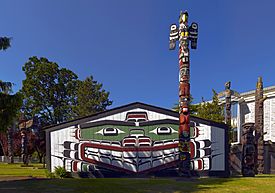Thunderbird Park (Victoria, British Columbia) facts for kids
Quick facts for kids Thunderbird Park |
|
|---|---|

Thunderbird Park
|
|
| Type | Public park |
| Location | Victoria, British Columbia, Canada |
Thunderbird Park is a special park in Victoria, British Columbia. It is located right next to the Royal British Columbia Museum. This park is famous for its many tall and beautiful totem poles. These poles show stories and symbols from different First Nation groups. You can see poles from the Gitxsan, Haida, and Kwakwaka'wakw peoples here. The park gets its name from the mythological Thunderbird. This powerful bird from Indigenous North American cultures is shown on many totem poles.
The park also has some important old buildings. One is St. Anne's Schoolhouse, built in 1844. Another is Helmcken House, built in 1852 by Dr. John Helmcken. You can also see Mungo Martin House, called Wawadit'la. This is a traditional "big house" of the Kwakwaka'wakw people. It was built in 1953 by Chief Mungo Martin. Thunderbird Park is part of the Royal BC Museum Cultural Precinct. This area around the museum has many historical sites and monuments.
Contents
Park History and Art
Why the Totem Poles Were Placed
Totem poles were first put up in this area in 1940. This was part of a plan to save some of the region's Aboriginal art. Many of these artworks were starting to decay. The site officially opened as Thunderbird Park in 1941.
Restoring the Totem Poles
By 1951, many of the original poles had become very old and damaged. So, in 1952, the Royal BC Museum started a special program to fix them. Chief Martin was the main carver for this important work. He was a very skilled artist.
Chief Martin passed away in 1962. After him, another famous carver, Henry Hunt, took over. Other talented artists also worked on this program. These included Henry Hunt's sons, Richard Hunt and Tony Hunt. Tim Paul, Lawrence Bell, David Gladstone, David Martin, and Bill Reid also helped.
New Poles and Preserved Art
All of the original totem poles were replaced with new versions by 1992. Some of the old, original poles are now kept safe inside the Royal BC Museum. This helps to preserve them for future generations.

